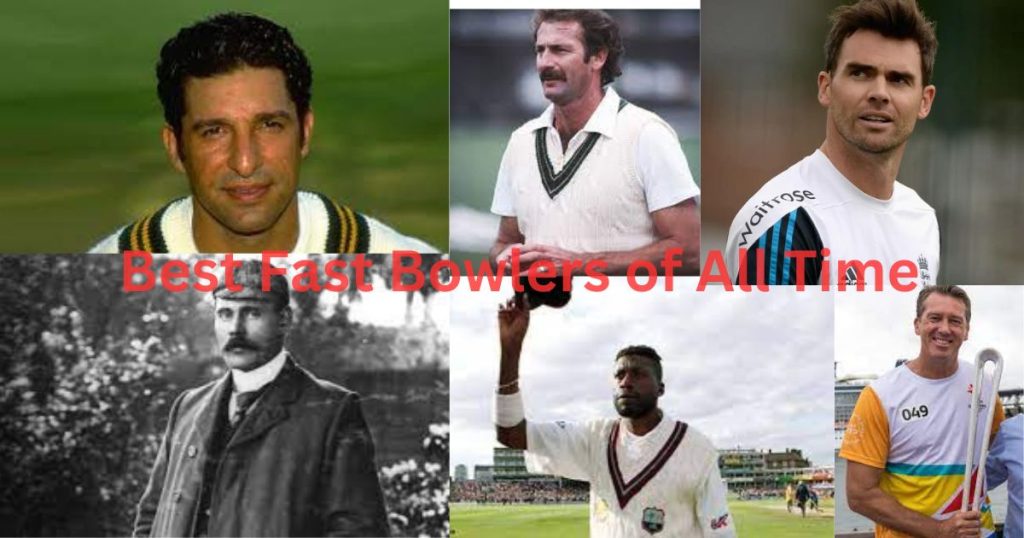Table of Contents
When moving through the record of cricket history, one cannot help but wonder at the skill of the best fast bowlers of all time, whose names are made into the sport’s weave. We look at the careers of James Anderson, Glen McGrath, Wasim Akram, Dennis Lillee, Sydney Barnes, and Sir Curtly Ambrose, all of who transformed the art of fast bowling.
James Anderson : The Swing Master
Our journey begins with James Anderson, an experience English bowler with a career total of 564 Test match wickets. Anderson’s entry into the cricketing world in 2003 drew eyes due to his unique action, but he quickly removed doubts with the deadly combination of swing and seam. Anderson’s away swinger and smart use of reverse swing make him a consistent performer even in his late 30s. He was a key player of England’s winning 2010 ICC World Twenty20 side.
Anderson had taken 686 Test wickets and 269 ODI wickets as of July 2023. His consistent change and low run rate confirm his standing as one of the best fast bowlers of all time.

Glen McGrath: Perfection Metronome
Glen McGrath comes as the pace for the cricketing symphony, offering discipline with every spell. McGrath’s impact on the Australian pace legacy is rare, with 563 Test wickets at an average of 21.64. His action began in 1993, and the cricketing world soon noticed his presence. McGrath’s statistics, especially an incredible strike rate of 51.9, set up his place among the best fast bowlers of all time.
McGrath’s prowess extends beyond Test cricket; in ODIs, he took 381 wickets at an economy rate of less than four. This shows his adaptability and excellence in both disciplines, establishing him as one of the best fast bowlers of all time.
Wasim Akram: The Sultan of Swing
Wasim Akram, recognized as the best left-handed bowler of all time, left his mark on the cricketing surface. His 414 Test wickets at an average of 23.62 show his power. Akram’s left-arm skill and a strike rate of less than 55 set him apart. His lifetime economy rate of less than 4 points to his control and ability to create matches.
Not only is Akram a Test legend, but his ODI supremacy is outstanding with 502 wickets, the most of any fast bowler. His legacy as the Sultan of Swing lives on, inspiring young cricketers even now and ensuring his place among the best fast bowlers of all time.
Dennis Lillee: The Trailblazer
Dennis Lillee, an icon in the fast-bowling world, broke records with style. In just 70 matches, he amassed 350 Test wickets at an average of less than 24, an incredible achievement. Lillee’s record as the first fast bowler to achieve the 350-wicket mark, along with an extremely low economy rate, confirms his place in cricketing history.
Lillee’s ODI debut saw him take 103 wickets in 48 matches, confirming his place as a true pioneer in the art of fast bowling. Lillee’s legacy lives on as one of the greatest fast bowlers of all time.
Sydney Barnes: The Artisan
Barnes was inducted into the ICC Cricket Hall of Fame in 2009, and his impact on the game is unrivaled. His 189 Test wickets at a brilliant average of 16.43 show his dominance. His distinct ability to take wickets on a regular basis marked him different in an age marked by courage and dedication.
Sir Curtly Ambrose: The Towering Force
Sir Curtly Ambrose, a West Indian great who left a clear impression, brings our journey to a close. Ambrose’s 6’7″ physique fearful batsmen all around the world, with 405 Test wickets at an average of 20.99. His record of bowling over 1000 maiden overs in 98 Test matches shows not only his wicket-taking abilities, but also his ability to crush rivals.
Looking on the careers of these best fast bowlers of all time shows that they were more than just players; they were artist who created masterpieces on the screen of cricket. Each delivery, wicket, and record shows an effort, skill, and unrelenting passion for the game. These bowlers’ legacy continue to inspire the cricketing world and grow in the hearts of fans as an icon to the beauty of fast bowling.
check out other articel 5 Best Wicketkeepers of All Time and 5 basic rules of cricket .
